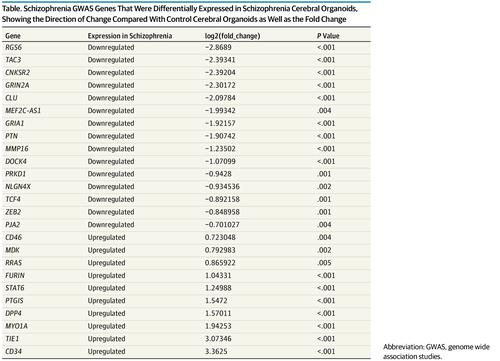JAMA Psychiatry ( IF 22.5 ) Pub Date : 2020-07-01 , DOI: 10.1001/jamapsychiatry.2020.0196 Annie Kathuria 1, 2, 3 , Kara Lopez-Lengowski 1, 2 , Smita S Jagtap 1 , Donna McPhie 3, 4 , Roy H Perlis 1, 3 , Bruce M Cohen 3, 4 , Rakesh Karmacharya 1, 2, 3, 4, 5, 6, 7

|
Importance Three-dimensional cerebral organoids generated from patient-derived induced pluripotent stem cells (iPSCs) may be used to interrogate cellular-molecular underpinnings of schizophrenia.
Objective To determine transcriptomic profiles and functional characteristics of cerebral organoids from patients with schizophrenia using gene expression studies, complemented with investigations of mitochondrial function through measurement of real-time oxygen consumption rate, and functional studies of neuronal firing with microelectrode arrays.
Design, Setting, and Participants This case-control study was conducted at Massachusetts General Hospital between 2017 and 2019. Transcriptomic profiling of iPSC-derived cerebral organoids from 8 patients with schizophrenia and 8 healthy control individuals was undertaken to identify cellular pathways that are aberrant in schizophrenia. Induced pluripotent stem cells and cerebral organoids were generated from patients who had been diagnosed as having schizophrenia and from heathy control individuals.
Main Outcomes and Measures Transcriptomic analysis of iPSC-derived cerebral organoids from patients with schizophrenia show differences in expression of genes involved in synaptic biology and neurodevelopment and are enriched for genes implicated in schizophrenia genome-wide association studies (GWAS).
Results The study included iPSC lines generated from 11 male and 5 female white participants, with a mean age of 38.8 years. RNA sequencing data from iPSC-derived cerebral organoids in schizophrenia showed differential expression of genes involved in synapses, in nervous system development, and in antigen processing. The differentially expressed genes were enriched for genes implicated in schizophrenia, with 23% of GWAS genes showing differential expression in schizophrenia and control organoids: 10 GWAS genes were upregulated in schizophrenia organoids while 15 GWAS genes were downregulated. Analysis of the gene expression profiles suggested dysregulation of genes involved in mitochondrial function and those involved in modulation of excitatory and inhibitory pathways. Studies of mitochondrial respiration showed lower basal consumption rate, adenosine triphosphate production, proton leak, and nonmitochondrial oxygen consumption in schizophrenia cerebral organoids, without any differences in the extracellular acidification rate. Microelectrode array studies of cerebral organoids showed no differences in baseline electrical activity in schizophrenia but revealed a diminished response to stimulation and depolarization.
Conclusions and Relevance Investigations of patient-derived cerebral organoids in schizophrenia revealed gene expression patterns suggesting dysregulation of a number of pathways in schizophrenia, delineated differences in mitochondrial function, and showed deficits in response to stimulation and depolarization in schizophrenia.
中文翻译:

精神分裂症中诱导的多能干细胞衍生的脑器官的转录组学景观和功能表征。
重要性 从患者诱导的多能干细胞(iPSC)产生的三维脑类器官可用于询问精神分裂症的细胞分子基础。
目的 通过基因表达研究,通过实时实时耗氧率测量和线粒体功能研究,以及微电极阵列对神经元放电的功能研究,确定精神分裂症患者脑类器官的转录组谱和功能特征。
设计,背景和参与者 本病例对照研究于2017年至2019年在马萨诸塞州总医院进行。从8例精神分裂症患者和8例健康对照组的iPSC衍生的脑类器官的转录组学分析中,确定了异常的细胞途径精神分裂症。诱导的多能干细胞和脑类器官是由被诊断为精神分裂症的患者和健康对照者产生的。
主要结果和措施 来自精神分裂症患者的iPSC衍生的脑类器官的转录组学分析显示,涉及突触生物学和神经发育的基因表达差异,并且丰富了精神分裂症全基因组关联研究(GWAS)中涉及的基因。
结果 该研究包括由11位男性和5位女性白人参与者生成的iPSC品系,平均年龄为38.8岁。来自精神分裂症中iPSC衍生的脑器官的RNA测序数据显示出与突触,神经系统发育和抗原加工有关的基因的差异表达。差异表达的基因富含与精神分裂症有关的基因,其中23%的GWAS基因在精神分裂症和对照类器官中表达差异:10个GWAS基因在精神分裂症类器官中上调,而15个GWAS基因被下调。基因表达谱的分析表明,与线粒体功能有关的基因失调以及与兴奋性和抑制性途径的调控有关的基因失调。线粒体呼吸研究显示较低的基础消耗率,精神分裂症脑类器官中三磷酸腺苷的产生,质子泄漏和非线粒体耗氧量,而细胞外酸化率没有任何差异。对大脑类器官的微电极阵列研究显示,精神分裂症的基线电活动没有差异,但显示出对刺激和去极化的反应减弱。
结论和相关性 对精神分裂症患者源性脑类器官的调查显示,基因表达模式表明精神分裂症中许多途径的调节异常,线粒体功能的差异以及精神分裂症的刺激和去极化反应均存在缺陷。











































 京公网安备 11010802027423号
京公网安备 11010802027423号